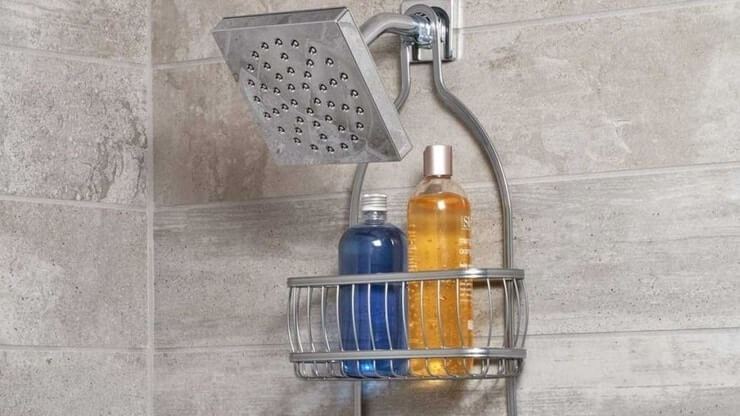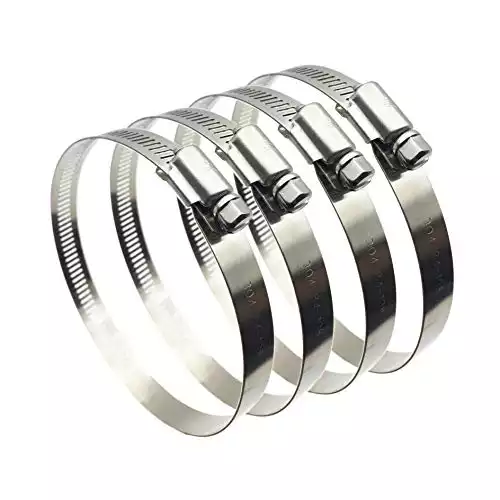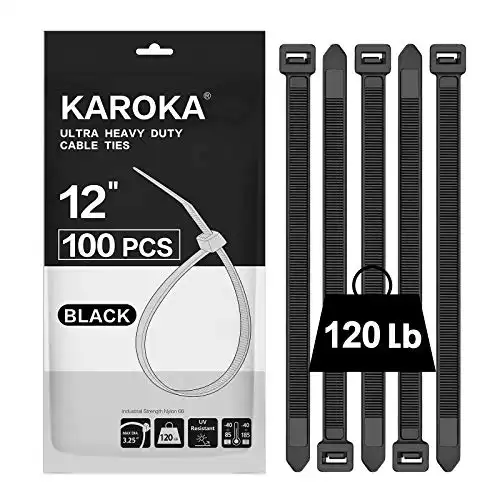Shower caddies are a lifesaver, but they can also be a headache.
They keep your shower less cluttered and your items less scattered, but they have one pretty inconvenient design flaw – shower caddies keep falling or sliding down!
Discover easy-to-implement solutions to prevent your shower caddy from falling or sliding down, so you can enjoy a clutter-free, hassle-free shower experience.

Why Does Your Shower Caddy Slip and Fall?
A shower caddy can keep slipping and falling due to several reasons.
Firstly, the lack of friction between the caddy and the shower head or wall can cause it to slip easily.
This is often the case with metal shower caddies, which have a smooth surface that makes it challenging to create friction.
Secondly, an unsuitable size of the shower caddy can also contribute to its frequent falling.
If the caddy is too loose to fit on the shower head, it may keep falling off.
Lastly, the moisture in the shower stall can make the surface of both the shower caddy and shower head slippery, causing the caddy to fall.
But don’t worry, there are plenty of ways to prevent the shower caddy from falling and slipping off the showerhead or tiles.
How to Keep a Shower Caddy from Falling Off the Shower Head
Keeping the shower caddy from falling is difficult, especially if it doesn’t fit perfectly.
But the great news is, you don’t have to go buy another caddy yet.
There are reliable solutions to keep your shower caddy in place.
Hose Clamp Method
The shower caddy clamps are an easy way to prevent your caddy from falling.
You probably already use these clamps on hoses and pipes around the house, like the one attached to your air conditioner.
If you don’t have any extras lying around in the house, hose clamps are cheap and readily available in hardware stores.
Hose clamps come in different sizes, so don’t forget to take the measurement of your showerhead neck before buying the properly sized hose clamp.
The only disadvantage of using hose clamps is they are mostly made of steel.
This means the clamp will rust over time, especially when exposed to excessive moisture in the shower.
Thankfully, rust-proof hose clamps are also available, so opt for them when possible.
Not only will they be rust-resistant, but they will also have an elegant industrial look to them.
How to Use It
Attach a hose clamp to the base of your showerhead and use it to hold the shower caddy in place.
Use a screwdriver to tighten the clamp to keep the caddy from falling.
Zip Tie Method
Another item easily available at home or in any hardware store that can keep your shower caddy from falling is a zip tie.
They are cheap, but make sure to use a strong enough and sufficiently long zip tie that can hold your caddy in place.
How to Use It
You have two options: the first one is to hang the shower caddy on the neck of your showerhead using the zip tie to keep it there.
The second method is to push the shower caddy far back until it touches the wall, then loop the zip tie in front of it to keep the caddy stable and prevent it from moving forward.
This solution will stop your shower caddy from falling or slipping down the shower.
Unfortunately, it’s not enough to keep the caddy from moving sideways.
Rubber Band Method
If you don’t feel like going to the store or spending extra money on zip ties or hose clamps, you probably have spare rubber bands lying around your house.
A couple of rubber bands will also work very well in securing your shower caddy, so it won’t fall in the shower.
How to Use Them
With the caddy in place, take three to four rubber bands and wrap them around the showerhead in front of the caddy.
Wrap the rubber bands two to three times or until they have a grip tight enough to keep the shower caddy from falling even when it gets slippery and wet.
The only challenge when using this method is tightening the rubber bands.
You’ll have to remove the showerhead first to fold the rubber bands twice or thrice or as needed.
Tapes
Another option is to use some tape around the shower pipe to hold the caddy in place.
But remember that most tapes lose their grip in wet and slippery conditions.
Tapes aren’t the best solution either since they are more visible compared to the methods mentioned above, and they often look ugly.
How to Keep a Shower Caddy from Sliding Down on Tiles
Typically, you hang shower caddies on the showerhead, but this method can sometimes lead to plumbing problems.
These problems are especially common if your caddy holds a considerable amount of weight.
Hanging the shower caddy on the tiles of your shower walls might be a good alternative.
You don’t need to drill holes in the tiles either.
You can use suction cups to stick the caddy on the tiles.
Unfortunately, the moisture and slippery tile mean your caddy might slip.
But don’t worry, there are ways to prevent this:
Choose the Right Spot
Put the suction cup of your shower caddy where it’s farther away from the shower spray or away from the showerhead’s range.
This way, it stays dry and protected from hot water that makes the suction cups come off faster.
Clean the Tiles Before Sticking On the Suction Cup
Dirty tiles won’t provide good suction.
Ensure the tiles are clean and dry before sticking on the suction cup, even if the surface doesn’t look dirty.
Remember to clean the suction cups as well.
Apply a Small Bit of Petroleum Jelly on the Tile
Enhance the suction by applying a small amount of petroleum jelly on the tile surface just before you stick in the suction cups on the tiles.
You only need a tiny amount to create an almost invisible layer on the tile surface.
Leave the Cup for 24 Hours Before Placing Any Weight on the Caddy
Once you place the suction cups on the tile surface, keep them there, unmoved, for at least a whole day before exposing them to water or putting any weight on the caddy.
‘Burp’ the Cups Now and Then
Make your caddy’s suction cup stick for longer by “burping” the cup every now and then.
Some air can get inside the vacuum over time, loosening its grip on the tile surface.
Burping them regularly will get rid of the air or bubble, keeping them tight and secure.




